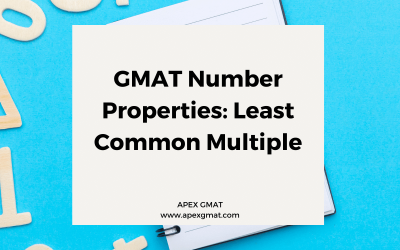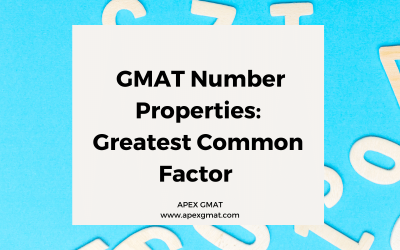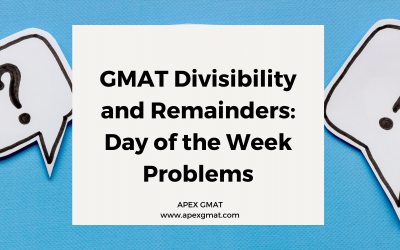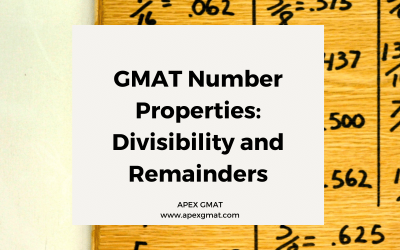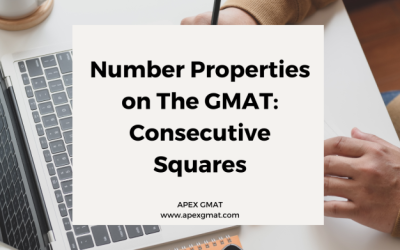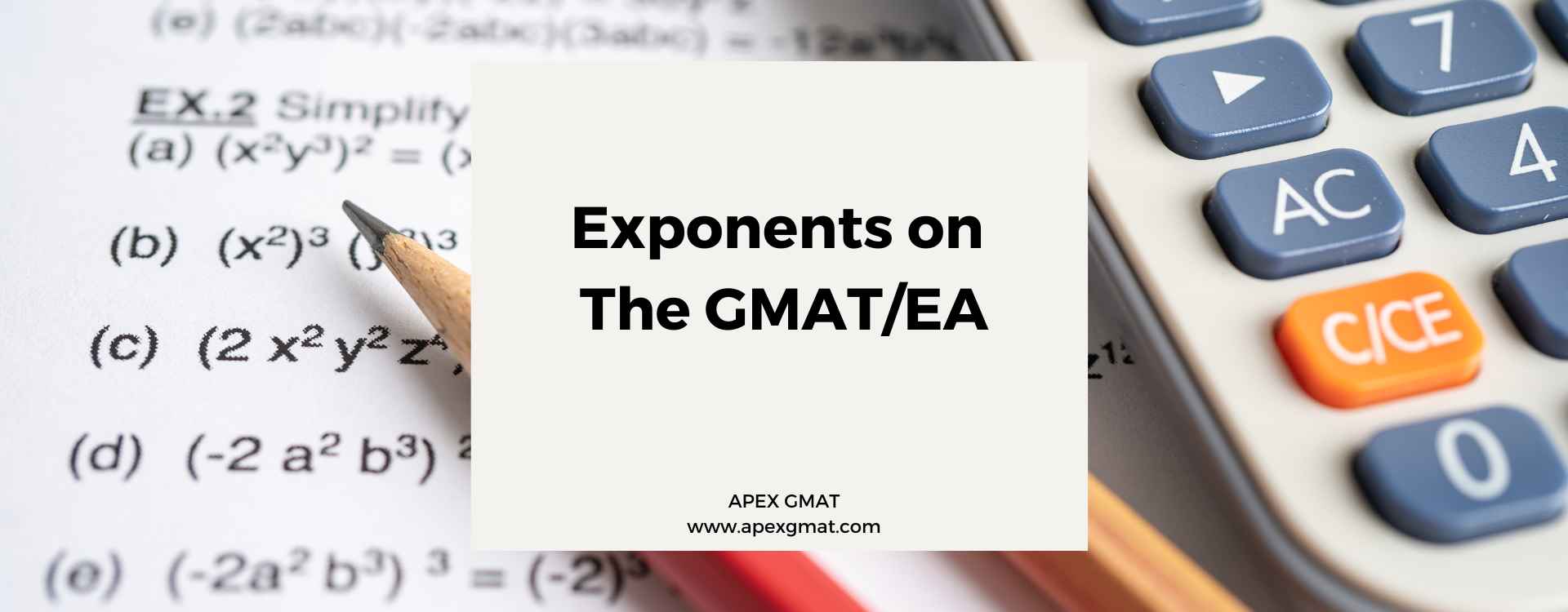Blog
Top Posts
No Results Found
The page you requested could not be found. Try refining your search, or use the navigation above to locate the post.
All Our Posts
GMAT Number Properties: Place Value Problems
Welcome back to our series on number properties. This article will introduce GMAT quant problems that revolve around the relationships between the digits of multi-digit integers. This topic can be tricky because we all know how the base-10 system works, but this...
GMAT Number Properties: Least Common Multiple
Welcome back to our series on number properties. In the last article, we learned how to find the greatest common factor/divisor of a set of integers. This article will cover the related topic of the least common multiple. Least common multiple The least common...
GMAT Number Properties: Greatest Common Factor
Welcome back to our series on number properties. This article will cover everything you need to know about the term “greatest common factor” or “greatest common divisor.” These terms refer to the greatest/highest/largest positive integer that is a factor or divisor...
GMAT Divisibility and Remainders: Day of the Week Problems
Welcome back to our series on number properties. In the last article, we introduced remainders. This time we will address my favorite use of remainders on GMAT quant: day of the week problems. Have you ever encountered a problem like this? Problems related to Days of...
GMAT Number Properties: Divisibility and Remainders
Welcome back to our series on number properties. In this article, we deal with the fallout of failed divisibility: remainders. Remainders exist whenever an integer is divided by another integer that is not one of its factors. When integer n is divided by integer x,...
GMAT Divisibility Rules
Welcome back to our series on number properties. Last time we got familiar with prime factors as the substance of divisibility. In this article, we will extend this understanding by highlighting logical rules that sometimes come into play on GMAT number properties...
GMAT Number Properties: Divisibility and Prime Factors
Welcome back to our series on number properties. In this article, we cover the heart and soul of number properties: divisibility, specifically as it relates to the prime factors of integers. Here’s the all-important fact: Divisibility boils down to shared primes....
GMAT Number Properties: Consecutive Perfect Squares
Welcome back to our series on number properties. In the last article, we explored the factors of perfect squares. This article will examine a special property of consecutive perfect squares. A commonly tested skill on the GMAT is the ability to recognize and...
Prime Factors of Perfect Squares
Welcome back to our series on number properties. Now that you know about prime factors, it’s time to learn a special property about the prime factors of perfect squares. Perfect squares are integers that represent the product resulting when some integer is multiplied...
Prime Factorization: The Building Blocks of Integers
One of the most fundamental and widely applicable skills for GMAT quant is the ability to break down integers to their prime factors. Integers are a class of numbers sometimes referred to as “whole numbers.” Integers can be positive, negative, or 0 in value, and they...
Exponents on The GMAT/EA: Everything You Need To Know
Understanding Exponents A key piece of algebraic notation on GMAT and Executive Assessment (EA) quant problems is the exponent. Exponents appear on many kinds of quantitative problems, so fluency with exponents (and radicals) is an indispensable skill for achieving a...
Large Exponents and The Units Digit
Welcome to the final article in our series on exponents. Some GMAT and Executive Assessment (EA) quant problems feature impossibly large numbers like 287459. These are problems that you simply can’t hope to solve without a key piece of knowledge that we call units...
Exponents: Power of k Problems
Welcome to the penultimate article in our series on exponents on the GMAT/Executive Assessment (EA). Today we explore a problem category in which exponents are used to notating the highest power of an integer by which a larger integer is divisible. GMAT/EA problems...
Zeros and Nonzeros
Welcome back to our series on exponents. Last time we used powers of 10 to express “almost integer” numbers. Today we will use powers of 10 to handle problems that ask us to count zeros or nonzero digits. These problems can be baffling if you haven’t learned about...
“Almost an Integer” Problems
Unless you do math as a career or a hobby, you probably prefer integers to non-integers. Whole numbers are easier for us to conceptualize. But a certain class of GMAT/Executive Assessment (EA) problems involves numbers that are almost integers. Generally, this nearest...
Powers of 10 and Scientific Notation
Many GMAT and Executive Assessment (EA) exponents problems involve the use of 10 as a base. Since all the math we do is in a base 10 system, multiplying or dividing by powers of 10 simply moves the decimal point of a number. This enables us to notate very large and...
Exponent Properties in Data Sufficiency
Exponents have properties that make them ideal pieces for data sufficiency problems on the GMAT and Executive Assessment (EA) quant sections. We’ve surveyed most of these properties in our first four articles in this series, but a couple of key ones haven’t been...
Bases Between -1 and 1
Many GMAT and Executive Assessment (EA) exponent problems - especially data sufficiency ones - require you to consider fractional bases. By this I mean proper fractions with values between -1 and 1, not improper fractions whose numerators exceed their denominators....
Negative Exponents and Negative Bases
Welcome back to our series on exponents. Today we will see what happens when we throw negatives into our exponential expressions. We will explore both negative bases and negative exponents. First, the bases. The rule to remember for negative bases is that odd powers...
Undoing Exponents: Radicals and Roots
As you will definitively have to deal with radicals on the GMAT and Executive Assessment (EA), we've put together an article for you to master the topic. Addition is “undone” by subtraction, multiplication is “undone” by division, and the powers notated by exponents...
Comprehensive GMAT Preparation
Step 1 – Complimentary Consultation
Step 2 – Assessment & Written Report
Step 3 – Work with a top scoring Apex trained instructor on your personalized prep plan.
Step 4 – Success
View our client success stories and find out how we position our clients to achieve and why we are the best choice for your success.
Book a Meeting Today!
Schedule a complimentary consultation call with one of our Instructors for Success with Apex . Act now as others have already done.


